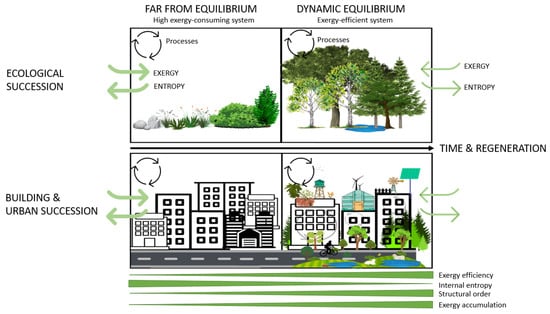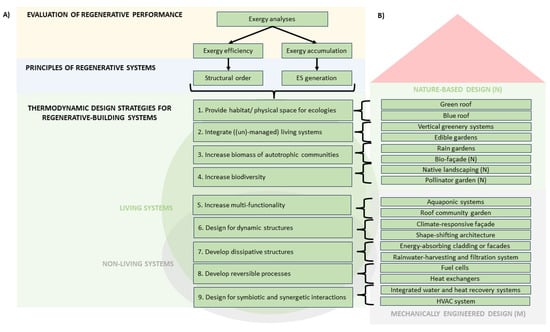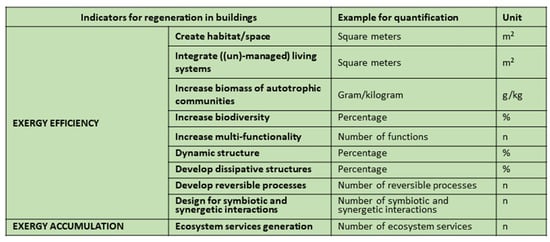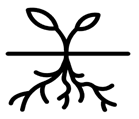Abstract
Regenerative design is being increasingly explored in urban environments to counteract and adapt to the changing climate and degradation of ecosystems. A critical success factor for the implementation of regenerative design is the evaluation of urban and building systems in relation to ecological performance and benefits. In biological ecosystems, the availability of high-quality energy, called exergy, and structural order can be used as indicators of the efficiency of on-going ecological processes. Structural order refers to the organization and systematic arrangements of biotic and abiotic elements within an ecosystem based on the available space and interactions with the goal to form a functional system. Ecological processes use the available exergy and generate ecosystem services (ESs) upon which human survival and that of other living organisms depend. In this article, structural order and ESs generation are proposed as indicators for exergy efficiency and accumulation in building systems, respectively, which can evaluate to what extent they are ecologically functional and regenerative. Based on this insight, design strategies are derived from the functioning of ecosystems that describe how buildings could become habitats that host living, non-living, and hybrid systems with optimized thermodynamic efficiency and that can generate ESs. This research suggests that when buildings improve structural order (an ecological concept) and implement ESs generating processes similar to biological ecosystems, they can facilitate regenerative processes more effectively that consume and generate resources and, with this, destroy but also accumulate exergy.
1. Introduction
The Need for Regenerative Buildings and Building Systems
Buildings and their operating systems are urgent focus points in the regenerative development of cities to mitigate climate change and environmental pollution []. Being the core elements of cities, building operations are responsible for 30% of global energy consumption and 26% of global energy-related emissions []. A total of 18% of the energy-related emissions stem from operational processes that consume electricity and from heating []. Other building operation processes, such as cooling, lighting, and sanitary systems like toilet flushing, consume ecosystem services (ESs), such as fuel or energy and fresh water, respectively. They further produce waste or pollution such as plastic, contaminated water, and greenhouse gas emissions []. To evaluate the extent of sustainability in buildings and their related systems, critical indicators and improvement strategies for regenerative performance are required.
From an ecological perspective, regenerative systems increase long-term resilience. Long-term resilience is only possible through effective ecological functionality and high energy efficiency in operational processes that facilitate the system’s functioning []. In this paper, the term ecological functionality is used when operational processes are on-going and ESs are generated. Regeneration in biological ecosystems and in buildings ultimately relies on long-term ecological functionality. Energy efficiency from a systems perspective requires exergy efficiency because the amount of available exergy, and therefore usable energy, is limited on the planet and within ecosystems. Exergy comes in energy, material, and information, and is defined as the amount of work that a system can perform when being in thermodynamic equilibrium with the environment []. All living and non-living systems in biological ecosystems, cities, and buildings and their operational processes, for example water purification or pollination, run on energy and provide services like fresh water and food, which are basic needs for human survival, as well as for all other life to exist []. All flows of energy in the known universe are determined by the laws of thermodynamics []. Ecosystems and buildings are thermodynamically open, which means that they exchange and transfer energy, information, and matter with their environment through transformation processes []. The concepts of exergy and entropy from the field of thermodynamics, as well as the ESs concept, can be used to evaluate energy efficiency and achieve regeneration in both ecosystems and buildings. Exergy efficiency and accumulation are elaborated upon and proposed as useful indicators for regeneration of building systems in this research.
In ecology, exergy, entropy, and ESs are interlinked through the thermodynamical functioning of ecosystems. The exergy concept allows people to describe and compare buildings and their systems as thermodynamical structures. The development of the theory and practice of regenerative architecture is partially inhibited due to a lack of conceptual theory that translates the regenerative functioning of biological ecosystems into the language of the theory and practice of architectural and building systems design and evaluation. Existing approaches found in the literature [,,,,,] fail to unite exergy, entropy, and ESs concepts in the context of regenerative buildings and cities which could be a root cause of ecologically ineffective designs. To close this gap and contribute to the regenerative development of the built environment, the presented work unites these concepts to provide a system-based approach to ecologically functional regenerative building and building system design.
Designing ecologically functional buildings would allow buildings themselves to more effectively and strategically generate ESs and with this alleviate pressure on biological ecosystems to provide resources. This is of key importance in urban environments where urban green and blue space cannot remain the sole source of urban ecosystem services. Urban green and blue space is decreasing in absolute area or on a per capita basis in many cities as the population increases and cities densify []. It is of great importance, therefore, that buildings are able to generate ESs to make cities more functional, more able to adapt to climate change, and to increase human wellbeing []. Ecological functionality in buildings can be achieved through strategies emulated from biological ecosystems []. This is often termed biomimicry. Biomimetic research has resulted in many buildings and products with improved functionality and energy efficiency. Examples include solar panels that imitate photosynthesis for energy generation and whale-inspired wind turbines with higher energy efficiency and less noise [,]. Despite the availability of multiple individual design strategies, there are few authors that apply a system-level analysis of strategies that biological ecosystems use to become regenerative and resilient []. In this paper, ecosystem-level biomimetic thinking [,] is employed in order to extract regenerative functional design strategies from biological ecosystem theory and translate them into practical application for the design and evaluation of buildings and building systems.
2. Theoretical Background
2.1. The Concept of Regeneration
Regeneration refers to the ability of a system to restore and renew itself over time to achieve resilience and adaptability to disturbances like climate change []. Regenerative performance in buildings implies a positive ecological impact on the environment over the complete building life-cycle while ensuring the wellbeing of building users and wider communities []. Biological ecosystems are the best-known examples of effective organization of life and regeneration on Earth []. They have the ability to self-generate, self-regulate, self-organize, and evolve their structures within planetary boundaries maintaining homeostasis, which is a stable state and the dynamic balance of the internal processes [,,]. This results from their structural set-up and efficient energy dynamics, two aspects that can act as a model for regenerative buildings and building systems [].
2.2. Thermodynamical Functioning and Exergy Analyses for Regenerative Systems
The scientific field of thermodynamics explains energy dynamics, particularly the transfer and transformation of energy and the relationship between different forms of energy including mechanical, electrical and chemical energy []. To measure the efficiency of energy transfer and transformation processes, exergy analyses can be conducted. In simple terms, exergy describes the maximum available high-quality energy in a system that can be used to carry out work []. Energy transfer and transformation processes consume exergy, and when the available exergy is used up in a system processes stop functioning and the system collapses []. Achieving thermodynamic balance in a system with many reversible internal exergy processes allows for the optimal functioning of the system over an extended period, because it responds to changes in the environment and contributes to the system’s ability to adapt and survive []. Through examining exergy balances and changes over time, exergy analyses indirectly also quantify exergy accumulation within a system []. Accumulated exergy allows a system to perform additional useful work as more useful energy is available.
Different types of exergies have been described []. Chemical and physical exergy, with the latter being divided into mechanical and thermal exergy, are the most commonly applied types for sustainability assessments, especially of non-living systems such as solar panels or plumbing systems [,]. The concept of information exergy quantifies the useful information within a system. Useful here means information that can be used to evolve, emerge, and adapt to disturbances in a changing environment []. In biological ecosystems, information exergy creates relationships leading to regenerative patterns, including a high level of biodiversity, ecological succession and ES generation that promote resilience and restoration through self-renewal, adaptation and self-organization []. For instance, living systems survive and evolve by transforming solar energy, called emergy, into complex, highly ordered structures such as biomass, which are directed and controlled by genetic information [,]. To date, biological systems have more efficient information transfer techniques than human-designed information systems [].
Biological ecosystems function in a state of thermodynamical non-equilibrium, meaning dynamic changes in structure and function emerge as specific ecosystem properties, such as soil properties, nutrient cycles or biodiversity, evolve. Due to this biological complexity, ecological exergy, called eco-exergy, is used to analyze living systems []. Eco-exergy refers to the amount of work that can be extracted from ecological processes, which includes the structure, organization, and relationships of an ecosystem [,,]. A comparative analysis for all exergy types revealed that individual living systems, such as plants, and biological ecosystems, such as forests, accumulate a significantly higher amount of both eco-exergy and information exergy, compared to engineered, human-made systems such as buildings []. This implies that the potential to learn from living systems in the design of human artefacts and systems, including buildings and building systems, is high. Moreover, the exergy concept facilitates the comparison between living and non-living systems and the evaluation and goal setting for building systems against an optimal, quantifiable example (i.e., living ecosystems).
Exergy analyses for urban and building systems already exist. Exergy efficiency calculations are applied to assess ecological processes such as nutrient cycling, environmental impacts such as pollution, and mechanical systems such as HVAC systems in buildings [,,]. However, their focus tends to be on chemical and physical exergy, excluding the biological concepts of information and eco-exergy [,,]. Despite the further development, acceptance and adoption of exergy analyses in recent years and their common and accurate application to building systems is still lacking [,,]. The exergy consumed in a physical, chemical, and biological system, including living organisms and ecosystems, is proportional to the generated entropy, which is therefore a relevant concept for the presented work [] and is explained in the next section.
2.3. Entropy Generation in Exergy-Efficient Systems
Entropy is a ‘measure of a system’s thermal energy […] that is unavailable for doing useful work’ []. Every energy transfer or transformation in living and non-living systems generates entropy []. Non-reversible, entropy-generating processes in biological ecosystems are energy dissipation in the form of heat, degradation of materials, natural disturbances like storms, wildfires or floods, genetic mutations, erosion and sedimentation, as well as aquatic mixing through wind or other physical forces leading to the distribution of substances like nutrients in the water [,]. Non-living systems in buildings such as electrical heating or lighting systems currently still perform predominantly high-entropy processes that include energy dissipation in the form of heat and contamination or pollution of substances such as water, air and soil []. Therefore, increased thermodynamic efficiency in building systems can reduce pollution and exergy consumption in the form of resources from external systems. Highly exergy-efficient and low-entropy-generating systems generally generate more ESs [,] and therefore support more life to exist [].
2.4. Ecosystem Service Generation with Building Systems
Biological ecosystems carry out ecological processes that generate ESs and sustain the functioning of the Earth’s biosphere and all life within it [,]. ESs represent the resources and processes that humans, and other organisms, benefit from and depend on. Therefore, their constant regeneration is essential. ESs can be divided into cultural, regulating, provisioning, and supporting ESs [] (Table 1). Cultural ESs such as relaxation and recreation are qualitative, non-material services. They depend on the availability of the material services and physical structures of ecosystems, which are called provisioning ESs, and include food, raw materials and fresh water. Regulating and supporting ESs form the basis for the provisioning of all other ESs, as they represent the underlying ecosystem structures and processes such as habitat provision, water- or soil-quality regulation [,] (Table 1). Several ES frameworks have been developed and are in use. Among them are the Millennium Ecosystem Assessment framework, the Intergovernmental Science-Policy Platform on Biodiversity and ESs framework (IPBES), and the Common International Classification of ES (CICES) [,,,]. Table 1 lists common ESs. Pedersen Zari [] applied the ESs concept to the urban built environment. Their integration is suggested because the high exergy consumption in cities leads in part to the depletion of ESs []. Buildings and their systems can integrate ES generation through design strategies and therefore improve their regenerative performance and alleviate pressure on non-urban ecosystems and urban green and blue space to provide ESs.

Table 1.
ESs categorized in four groups—supporting, regulating, provisioning, and cultural ESs (adapted from []).
2.5. System Thinking for More Regenerative Buildings
The functioning of many contemporary cities and buildings can be compared to the early stages of ecological succession, where high entropy processes dominate and exergy is, correspondingly, low. Ecological succession describes the process by which the structure and species composition of an ecosystem change over time in response to abiotic and biotic factors []. In the development towards the final stage of ecological succession with high exergy efficiency, the complexity and order of an ecosystem increases in different ways, including through the accumulation of structure in the form of biomass, the increase in information in the form of biodiversity, and the increase in cooperative-based interactions like pollination [,,]. A transformation of buildings and whole cities to function more regeneratively could thermodynamically be compared to the development of a climax state of a biological ecosystem. Such a system tends to be relatively dynamically stable, self-sustaining and long-lasting, three characteristics that buildings and cities also aim for.
Sustainable building design is typically linked to energy optimization and the reduction of material consumption by increasing resource efficiency and recycling. Regenerative design theory and practice pushes building professionals to move beyond sustainability practices, aiming instead for ecological functionality where humans symbiotically co-evolve with the rest of life and ecosystems on the planet. To become resilient and regenerative over the long term, buildings should mimic the functional principles of exergy efficiency and be able to generate ESs. Extracting features of ecosystem functioning that are useful for emulation in a built-environment context is a challenge that might be tackled by linking ecological and thermodynamic concepts [].
Ecosystem-level biomimicry can be a useful practice to examine ecosystem functioning and emulate it in building systems []. Biomimicry is a multidisciplinary research field that generally aims at designing sustainable products and systems by emulating biological forms, processes and ecosystems []. Ecosystem-level biomimicry emulates structures, functions and processes from biological ecosystems to develop sustainable, resilient and regenerative solutions for anthropogenic systems [,]. It employs a systems-thinking approach, recognizing the interconnectedness of ecological, social and economic systems, and seeks to address complex challenges by considering system impacts and feedback loops associated with human developments and activities [,].
3. Materials and Methods
As is more common in the field of architectural theory, a literature study following an integrative approach was used, meaning the aim was not to cover all articles published on the topic, but rather to compare and combine perspectives to create new theoretical models that do not appear in the literature. The purpose of this approach was to synthesize, by critically discussing, concepts from different fields (architecture, ecology, and thermodynamics) with the aim of producing a framework, theory, classification or taxonomy []. To further develop a theory-based framework for regenerative building design, the concepts of exergy, entropy and ESs were synthesized. A conceptual model was developed in Section 4.1 which represents commonalities and connections between the thermodynamical functioning of biological ecosystems and building systems. Structures and processes of ecosystems were analyzed, and those that support a regenerative ecological development were extracted and united in Section 4.2, as being useful for the improvement of the regenerative performance of building systems. In order to make these comparisons and create these synthesized theoretical frameworks, a logical-argumentation research methodology [] was used. This is the process of understanding and constructing evidence-based reasoning underpinning the abstraction and translation of ecological theory into quantifiable building design and systems thinking and the evaluation of building performance at the developed-design and in-use evaluation stages of the building process. Examples of existing building designs are provided in Section 4.2 to illustrate the potential application of the conceptual model to buildings.
4. Results
4.1. Conceptual Model for Evaluating Regenerative Performance of Building Systems
This section extracts indicators from ecology theory that may be useful in evaluating the ecological aspects of building-systems performance. The same indicators used for biological ecosystems are used to aid in the defining of design goals regarding the ecological functionality of buildings. Biological ecosystems can reveal high regenerative performance because their underlying processes strive to maximize exergy efficiency and decrease internal entropy [,]. Mimicking the functioning of biological ecosystems in buildings might therefore facilitate higher functional performance by moving towards minimal energy and material expenditure.
Achieving regeneration and optimized exergy efficiency in biological ecosystems develops over many years, through ecological succession. This process often involves minor fluctuations and disturbances that temporarily consume more exergy and generate more entropy [] (Figure 1). Nevertheless, fluctuations and disturbances can support the ecosystem to successively achieve a higher level of exergy efficiency through the emergence and evolution of structural order, for example, in the form of interactions between biotic and abiotic elements, biodiversity, and biomass []. Structural order refers to the organization and systematic arrangements of biotic and abiotic elements within an ecosystem based on the available space and interactions, with the goal of forming a functional system []. The most exergy-efficient order within a structure, therefore, adapts to the required functions []. Such temporary fluctuations and disturbances can also occur in buildings, for instance in refurbishing or remodeling processes to adapt to the evolving needs of users. Often, the structure of a building is then re-adapted to changed or new functions which can lead to an optimized exergy efficiency (Section 4.2). Similar to biological ecosystems, short-term modification of functional performance in buildings might also be required due to disturbance, for instance in an increased need for air-filtration during pandemics like COVID-19, or an increased need for heating during cold periods or repair after extreme weather events. Such fluctuations that can cause a decrease in exergy efficiency are usually temporary, until the system regenerates again.

Figure 1.
Visualization of ecological versus building and urban successive development towards a regenerative system over time. High (bold arrows) and low (thin arrows) exergy consumption and entropy generation is depicted in early and late stages of ecological and building and urban succession, where exergy efficiency, structural order, and exergy accumulation increase, whereas entropy generation decreases.
Exergy analyses point out exergy inefficiencies in building systems and can be used to guide the improvement of building systems towards higher regenerative performance []. Exergy efficiency relies on heat processes that generate low entropy and contribute to exergy accumulation within a system []. High-exergy-efficient systems usually accumulate more exergy within the system than systems with predominantly low-exergy-efficient processes []. Generally, the lower the entropy generation in a process, the slower a system reaches equilibrium stagnation and collapse. Therefore, low-entropy processes usually make systems, including building systems, more resilient, as an important aspect of regeneration []. Accumulated exergy facilitates ecological processes like temperature or water-quality regulation, generating ESs []. For instance, clean water accumulates more eco-exergy than contaminated water because more potential work can be performed with clean compared to contaminated water and high-nutritional food contains more exergy compared to detritus [].
Exergy accumulation can be estimated in living and non-living building systems by quantifying and monitoring ESs generation over a period of time. Although ESs and exergy represent different aspects of systems and are measured and conceptualized differently, they are related. ESs are diverse benefits provided by biological ecosystems to humans and non-humans. Exergy, on the other hand, is a thermodynamic concept that quantifies the maximum useful work that can be obtained from a system. The link between both concepts arises because ESs contain exergy as useful work potential that supports life-sustaining processes through generating fresh water, food and fertile soil, for instance []. Furthermore, identifying the exergy content of ESs gives insights into ES quality for sustaining life and ecosystem processes, for example, through the amount of chemical energy stored in biomass or the amount of nutrients in food []. Therefore, linking the concept of exergy to the concept of ESs makes the ecological aspects of regenerative design more measurable and more easy to define as sets of performance goals, and therefore perhaps more possible to design well.
Since all living and non-living systems consume exergy, building systems also need to find the most efficient dynamic equilibrium between exergy generation and consumption, in order to become ecologically regenerative. When ESs are consumed, exergy is destroyed, and when ESs are generated, exergy is accumulated temporarily until the ESs are consumed again. When exergy is accumulated, new processes can develop and ESs can be generated. Therefore, to increase the ecological functionality and resilience of buildings over long periods, the largest possible amount of exergy has to be integrated into building systems. When building systems generate all the ESs that are consumed within the building, they become independent from the ESs generated in non-urban ecosystems, and therefore can avoid their further exploitation, meaning more ESs are available to other life forms, which in turn creates healthier ecosystems that support human wellbeing []. Furthermore, with an increase in ESs generation in buildings, they can host more life, including humans and non-humans. Consequently, exergy efficiency and ES generation are proposed as indicators for the regenerative performance of a building system.
In order to evaluate and compare exergy efficiencies of building systems and ecosystems, exergy analysis can be conducted for living and non-living building systems using an existing formula or by evaluating their level of structural order []. Exergy analyses require quantifying of not only physical and chemical exergy, but also of information and the eco-exergy of a system. This allows for a close-to-reality estimation of exergy efficiency []. Furthermore, exergy is calculated in the unit of ‘joules’ and therefore offers a way to accurately assess and compare the regenerative performance of different building systems. Structural order can be evaluated by using the extent of implementation of the regenerative-design strategies listed in Figure 2 as indicators (Figure 3). More detailed work that links existing regenerative-design strategies for buildings to ESs generation can be found in the ‘strategies for designing urban ecosystem services’ diagram [].

Figure 2.
(A) Thermodynamic design strategies to achieve regenerative-building systems that are exergy-efficient through structural order and accumulate exergy through ES generation. (B) Examples of building systems that can be implemented and evaluated according to their thermodynamic functioning.

Figure 3.
Checklist of extracted strategies from biological ecosystems identified as useful indicators for regeneration in buildings, with one example of how each can be quantified.
As a summary, ecological processes, summarized here primarily as the regulating ESs, are critical for the generation of provisioning ESs []. Current building systems are designed to distribute provisioning ESs and cover basic human needs; however, they rarely generate regulating ESs. Instead, the built environment largely relies on non-urban biological ecosystems to provide regulating and provisioning ESs. Consequently, to achieve a higher regenerative performance of building systems, it is critical for building professionals to aim at ecologically functional designs that generate regulating ESs and, through them, provisioning and cultural ESs. Regulating ESs can be quantified using biophysical assessments, for instance through spatial data, modelling, indicators, and mapping []. Thermodynamically open systems like ecosystems and buildings can only be considered regenerative and become ecologically resilient when the ESs that are consumed are being regenerated within the defined structural boundaries.
4.2. Thermodynamic Design Strategies for Regenerative-Building Systems
In this section, principles and strategies to achieve higher exergy efficiency and accumulation through structural order and ESs generation were extracted from biological ecosystems and translated to building systems. The functioning of a building still differs from that of a biological ecosystem in several aspects that affects thermodynamic efficiency. While both buildings and ecosystems can be considered thermodynamically open systems, their structure, purpose, and processes are divergent (Figure 2). These major functional differences between buildings and biological ecosystems can give insight into what design principles of biological ecosystems can be useful to emulate and implement when developing regenerative-building systems (Figure 2). The following nine strategies were identified as essential structures and processes of biological ecosystems that allow for exergy efficiency, low entropy and high ES generation. These strategies can already be emulated in building systems through existing nature-based, hybrid, or mechanical designs, to achieve a more regenerative performance (Figure 2). Nature-based design works with biological systems like plants, soil and water; for example, raingardens as water catchment systems or erosion control by means of vegetation, with their root systems added to unstable soils []. Nature-based designs also include hybrid designs like vertical greenery systems that make use of mechanical engineering and living systems. Mechanically engineered designs refer to designs or machines that exclude the use of living systems or bio-based materials. Both mechanically engineered and nature-based designs can be biomimetic and inspired by biological systems. Following the model of biological ecosytems, a building can function more regeneratively when multiple strategies are combined and implemented. The proposed strategies should be seen and applied as system-based adaptations that can increase the self-sufficiency of buildings while creating ecological functionality through ES generation like water and air purification, habitat provisioning, or temperature regulation.
- Strategy 1: Provide habitat/physical space for ecologies
Integrating spaces into or onto buildings where organisms can populate and develop through self-organization and with minimal human management may allow for the evolution of location-specific ecological niches []. The advantage of living systems over non-living systems is the emergence of new relationships []. More interactions can increase the functionality, regenerative value, structural order and resilience of the whole system.
- Strategy 2: Integrate ((un)-managed) living systems
Adding living systems to buildings can naturally increase adaptative potential to internal and external system changes, for instance through biological sensors reacting to light, rain or wind []. Buildings predominantly host human-made non-living systems built with technology that consumes large amounts of energy and exergy in the form of oil, gas, and other natural resources []. Examples are battery systems, solar photovoltaic systems, and fossil fuel power plants []. Biological ecosystems also contain non-living components such as organic matter, water, air and minerals, but they consist predominantly of living systems like microbes, plants, and animals, and their interactions []. Living systems can be biological early-warning indicators for systemic changes when observing fluctuations in species numbers and composition []. For example, high biodiversity indicates resilience to disturbances, while fluctuations in population size of species indicate changes in environmental conditions []. Indicator species that are sensitive to environmental changes such as amphibians, lichens, or mosses, can also be used as environmental indicators for water and air quality, as well as soil fertility, among other related aspects of ecological health []. For instance, the lichen diversity value (LDV) is used to identify the degree of air pollution in a specific area, while certain moss species like Hylocomium splendens can be used as indicators for fungi in the soil, which again indicate that contaminants are present [,]. Exergy efficiency can differ by species, and depends on their interaction with the local environment []. Therefore, ecological assessments, either observational or quantitative, are useful for decision-making regarding which species to grow on or in buildings.
- Strategy 3: Increase biomass of autotropic communities
Integrating autotrophic communities such as terrestrial and aquatic plants or microorganisms increases biomass, which is a form of structural order. An increase in biomass in autotrophic communities leads to increased energy input in net primary production, creating positive feedback where greater exergy storage at the primary-producer level allows for additional exergy availability in the whole system []. More exergy availability in the building also implies more work potential that can be used to run building systems, for example, heating or electricity systems. An important factor to reach exergy efficiency in living systems is time. This means that the longer a living system has been implemented in the building, the higher the exergy efficiency of on-going processes tends to be []. This implies that autotrophic communities in and on buildings develop their full regenerative potential and exergy efficiency over time, and therefore require appropriate ecological management. It also implies that by creating more positive feedback in building systems, the process of improving exergy-efficiency may be accelerated. Currently, not all, but only isolated parts of the building system, like an HVAC system, achieve a comparable positive feedback. The implication of this is that the design process extends beyond the point a building is built, to having a role in the continual evolution of living and non-living building systems over time.
- Strategy 4: Increase biodiversity
Increasing biodiversity, especially of autotrophic communities, increases net primary production under limited space and fluctuating temperature, water, nutrition, and solar availability, which augment structural order []. With increased biodiversity among the three main actors of the trophic web (producers, consumers, and decomposers of biomass) the metabolic pathways of an ecosystem increase in complexity []. When different species with different ecological requirements including nutrients, water, or light co-inhabit a building, resource utilization and distribution become more efficient, increasing the system’s functional diversity []. More biodiversity generally creates a positive feedback loop, as more life can be supported due to developing synergetic relationships based on cooperative interactions []. Due to the exergy consumption in on-going ecological and metabolic processes, temporary fluctuations between positive and negative feedback related to exergy availability can occur []. Biodiverse ecosystems integrated into buildings can therefore affect resource and energy provisioning. However, multi-functional design and backup-systems for resources and energy availability, linked to the neighborhood or urban-scale system, can compensate for potential fluctuations (see Strategy 5, 6, 7 also) [].
- Strategy 5: Increase multifunctionality
Increasing the multi-functionality of living and non-living building systems contributes to increased structural order and ESs generation []. While living systems are generally multi-functional at the expense of quantity per generated ESs, human-designed systems mostly generate a high quantity of one ES at the cost of multi-functionality []. An effective strategy to accumulate exergy within building systems can be to make sure they perform multiple ecological functions simultaneously or intermittently. Examples of multifunctional-building designs are vertical greenery systems that can generate several ESs at the same time, including temperature regulation, air filtration, and habitat provision for plants and animals []. Lists of existing ES-generating building designs have been published [,]. Although not all ESs might be generated by a single building, several buildings together can potentially form a regenerative exergy-efficient nexus that produces and exchanges ESs.
- Strategy 6: Design for dynamic structures
Designing buildings as and with dynamic systems similar to those of biological ecosystems allows for more interactions between living and non-living systems and with their physical environment. Dynamic systems adapt their interactions to internal and external requirements, and can in this way change the system’s structure over time, aiming to achieve the highest material and energy efficiency []. Buildings are human-made and are typically static structures over the medium-to-long term. Creating dynamic building systems can adapt the boundaries of a building and make them more permeable, similar to those of biological ecosystems, resulting, perhaps, in more effective exchange of resources, energy and materials.
- Strategy 7: Develop dissipative structures
Designing buildings as open structures that exchange materials, energy and information with their environment, for instance with other buildings or green and blue urban areas, increases the physical space available to act or adapt. In that space, circular feedback loops can be created that improve exergy efficiency within the building system and potentially also at the neighborhood or urban scale. Currently, building systems are designed for determined functions, and often provide controlled and rather isolated indoor environments for human activity []. Building walls, roofs, windows, and doors typically separate the indoor from the outdoor environment, especially in temperate and cold climate zones. Most buildings currently host few living organisms or ecosystems, and therefore show a limited number of emerging relationships and patterns, as well as exchange of energy, matter, and information between building systems and with the environment []. Currently, exchange of energy, matter and information is mainly focused on heating, cooling, and lighting systems, in addition to an exchange of materials; for example, during renovation or maintenance work, and in the production of large amounts of ‘waste’ during operation []. Buildings could be developed as open structures with a complex network of extensive, synergetic interactions between living and non-living systems and with their environment, where a continuous exchange of energy, matter and information leads to higher exergy efficiency and regenerative performance, and improved, human wellbeing, for example, relating to thermal comfort and indoor air quality (see Strategy 9).
- Strategy 8: Develop reversible processes
Reversible processes result in exergy efficiency in living and non-living systems [,]. Non-living systems such as mechanical systems like heat pumps or batteries can be engineered as largely reversible processes, for example through reversible heat exchangers or fuel cells, respectively [,,]. A predominant example of reversible processes in biological ecosystems is photosynthesis, here solar energy is the primary source of energy and energy transformations to chemical and other forms of energy are exergy-efficient, with low entropy generation []. Energy is stored in the form of exergy in biomass and information and is distributed through the food web composed of producers, consumers and decomposers within the ecosystem []. Apart from solar panels, buildings still mainly rely on external energy sources including fossil fuels and electricity from the grid []. These energy systems generally consume more exergy and generate more entropy than energy transfers and transformations in biological ecosystems []. Storing energy as biomass and information is possible in buildings, while energy distribution can mimic exergy-efficient structures and the symbiotic and dynamic interactions of a biological food web, where no waste is generated (see strategy 9).
- Strategy 9: Design for symbiotic and synergetic interactions
Symbiotic, cooperative-based and synergetic interactions in ecosystems play a crucial role in ES generation, as they can enhance structural order and the overall functionality of the system, leading to exergy efficiency and, therefore, a higher potential for exergy accumulation [,]. Buildings can develop such interactions within and between living and non-living systems, mimicking the interactions found in biological ecosystems. For instance, water filtration through soil and plants simultaneously benefits nutrient cycling and provides a habitat for living organisms []. At the same time, water might flow through habitats where food-producing plants grow that also regulate temperature locally. While synergetic relationships generally emerge in living systems, non-living systems need to be designed for collaborative relationships with mutual benefits. Creating more relationships within and between living and non-living systems can lead to more complexity, with increased information transfer in buildings. This may ultimately lead to the emergence and evolution of a highly structured and resilient hybrid buildings, integrating living and non-living systems, to create a habitat for humans and non-humans alike.
5. Discussion
In the development of regenerative cities that are maximally self-sufficient and synergistically interrelated, buildings play an essential part as interacting physical subsystems. It is therefore critical to design buildings and their systems to be as regenerative as possible. Linking existing scientific concepts from ecology and thermodynamics to buildings and their systems demonstrates the potential of interdisciplinary research to achieve ecological regeneration in buildings. Uniting concepts and knowledge related to regeneration from different fields of expertise contributes to a more accurate definition of regeneration for buildings. Ecological regeneration through buildings and building systems may be more possible and quantifiable when mimicking and integrating appropriate design strategies from biological ecosystems that demonstrate high exergy efficiency and ES generation.
When applying the comparison of regenerative buildings with a climax ecological community at a late stage of ecological succession, as is carried out in this research, it must be understood that achieving a thermodynamic equilibrium and fully reversible processes is a theoretical ideal, rather than a common reality in ecosystems []. Ecosystems maintain an ecological equilibrium through maximally reversible processes like homeostasis; however, they are influenced by external factors, disturbances, and on-going changes, preventing them from reaching a perfect dynamic equilibrium state with the environment []. Therefore, achieving a thermodynamic equilibrium in the context of buildings implies an ecological equilibrium with high exergy efficiency in terms of energy, information and material flow. While the entire building may not be in strict thermodynamic equilibrium, individual components and processes within the building could exhibit characteristics of dynamic balance and stability.
Decision-making and design that target the increase of exergy efficiency and ES generation can lead to a reduction in the environmental impact of built environments, resulting in higher sustainability and ecological regeneration. This research contributes to the development of a conceptual framework approach for measuring and comparing ecological regenerative performance of building systems by identifying quantifiable indicators. Despite their complexity and time-intensiveness, due to the quantity and thermodynamic interconnectedness of different on-going processes in a system, exergy analyses offer higher accuracy in estimating regenerative performance compared to indirect indicators alone like structural order and ESs generation, which were outlined in Figure 2 and include the increase in habitat, multi-functionality, and interactions [,,]. Moreover, the quantification unit is the same in exergy analysis for all types of building systems, while for structural order and ES generation different quantification units are used, which can impede comparability of regenerative performance. Nevertheless, this research shows that monitoring the latter can also be useful in estimating the ecological regenerative performance of building systems. The advantage might be a more straightforward way of quantification, with tangible assessment methods stemming mainly from ecological sciences. Furthermore, the very technical calculations for exergy efficiency and accumulation in building systems might be less understandable to building professionals and users than the analysis of structural order and ES generation, which can often be directly linked to the structural set-up of a building and the consumption patterns, respectively.
Translating ESs directly into exergy accumulation within a system is mathematically not a straightforward process. However, considering the energy flows and transformations within biological ecosystems, thermodynamics and ESs are linked because ESs have an exergy content, which can therefore be seen as a temporary exergy accumulation in the system []. ESs involve a broader range of values and functions, including social, cultural, and economic aspects, which may not be fully captured by exergy analysis alone. Nevertheless, integrating the thermodynamic concept of exergy into regenerative building assessments bears high potential for a more holistic and complete evaluation of the regenerative performance of a building.
The suggested indicators for the ecological regenerative performance of building systems in this research can be used for living and non-living systems. Existing research applies exergy analyses to non-living building systems; however, ecology theory provides approaches to conducting exergy analyses for living systems also, which are increasingly integrated into or onto buildings [,,]. With their living and non-living systems, buildings could improve their dynamic adaptation to the environment and share information through genetic diversity and knowledge transfer. When coupling regenerative buildings and their systems, synergies can form and emerging regenerative properties can develop.
This research provides a list of design strategies that can increase exergy efficiency and accumulation in building systems through higher structural order and ESs generation. This provides building professionals with concepts to improve ecological regeneration in building systems. Current publications on sustainability assessments mainly focus on quantifying the negative impacts of non-regenerative-building designs and systems []. However, this research proposes ways to systemically design ecologically regenerative-building systems and measure positive impacts in both ESs generation and exergy efficiency. To ensure ecologically regenerative performance in building systems, frequent monitoring is required, and should become an essential part of facility management during the building usage phase.
In this research, the ecological aspects of regeneration are the focus. Future research should also integrate the social aspects of regeneration into buildings. This will require collaboration with experts from the fields of social and psychological sciences. Further research should also elaborate on mathematical formulae to measure and calculate all types of exergy efficiencies and ES generation in building systems. Furthermore, future work can link the proposed indicators for ecological regeneration in buildings to economic benefits that can be obtained when designing with more regenerative strategies. Research is required to collect empirical reference data on exergy-efficient processes and mechanisms and regeneration from biological ecosystems. Such data would allow the comparison of the ecological regenerative performance of a building with that of a biological reference habitat. Moreover, future research should link entropy analysis to building systems in addition to exergy analysis, to increase the accuracy of evaluating regenerative performance.
6. Conclusions
The aim of this research was to demonstrate the potential and importance of linking different existing ecological concepts for the purpose of evaluating and improving ecological regeneration in buildings.
This research advocates for the integration of regulating ESs into building systems as processes that add ecological functionality to building design. Exergy efficiency and accumulation analysis are also proposed as quantifiable indicators to examine and compare the regenerative performance of building systems with higher accuracy. Since structural order in a system leads to exergy efficiency and ES generation represents exergy accumulation in the system, those are alternatives that can be quantified and monitored over time to estimate the regenerative performance of building systems. To identify the exergy efficiency of living and non-living systems in buildings, eco-exergy and information exergy should be assessed, in addition to physical and chemical exergy.
When building professionals such as architects and engineers design with these strategies in mind, they may be more effectively able to increase ecological regeneration through buildings and building systems.
Author Contributions
Conceptualization, K.H. and J.A.; methodology, K.H., M.P.Z. and J.A.; investigation, K.H., M.v.d.V. and A.O.R.; writing—original draft preparation, K.H.; writing—review and editing, K.H., M.P.Z., J.A. and A.O.R.; visualization, K.H. and A.O.R.; supervision, J.A., M.P.Z. and K.H.; project administration, K.H. All authors have read and agreed to the published version of the manuscript.
Funding
This research received no external funding.
Conflicts of Interest
The authors declare no conflicts of interest.
Glossary
Ecological succession: The change in species composition and structure of an ecological community towards a stable state and dynamic balance internally and with its environment. Emergy: total solar energy invested directly and indirectly in the production of goods or usable energy, including for the maintenance of dynamic systems such as ecosystems. Entropy: A measure of a system’s thermal energy that is unavailable for carrying out useful work needed for energy transformations and transfers. Exergy: Available high-quality energy in a system that represents the maximum useful work that can be obtained from a system for energy transformations and transfers. Exergy analysis: Quantification of the efficiency of exergy transfers and transformations within and between systems, also identifying exergy destruction and losses. Exergy accumulation: Acquired amount of exergy in a system as a result of a higher exergy input than exergy output and exergy destruction (Exergy input–Exergy output–Exergy destruction = exergy accumulation). Homeostasis: A stable state and dynamic balance of the internal processes of a living system, allowing for optimal functioning of a system over an extended time period. Thermodynamics: Branch of physical science explaining energy dynamics, particularly the transfer and transformation of energy and the relationship between different forms of energy including mechanical, electrical and chemical. Thermodynamically open system: Dynamic systems that maintain their structure and functionality through the continuous exchange of energy and matter with their environment.
References
- Sharifi, A. Trade-offs and conflicts between urban climate change mitigation and adaptation measures: A literature review. J. Clean. Prod. 2020, 276, 122813. [Google Scholar] [CrossRef]
- Iea50 Buildings-Tracking Buildings. Available online: https://www.iea.org/energy-system/buildings (accessed on 18 July 2024).
- Zhong, X.; Hu, M.; Deetman, S.; Steubing, B.; Lin, H.X.; Hernandez, G.A.; Harpprecht, C.; Zhang, C.; Tukker, A.; Behrens, P. Global greenhouse gas emissions from residential and commercial building materials and mitigation strategies to 2060. Nat. Commun. 2021, 121, 6126. [Google Scholar] [CrossRef]
- Gatto, A.; Drago, C. A taxonomy of energy resilience. Energy Policy 2020, 136, 111007. [Google Scholar] [CrossRef]
- Jørgensen, S.E. Exergy. In Encyclopedia of Ecology (5-Volume Set); Elsevier: Amsterdam, The Netherlands, 2008; pp. 1498–1509. [Google Scholar]
- Lu, H.; Fu, F.; Li, H.; Campbell, D.E.; Ren, H. Eco-exergy and emergy based self-organization of three forest plantations in lower subtropical China. Sci. Rep. 2015, 5, 15047. [Google Scholar] [CrossRef] [PubMed]
- Zhou, J.; Ma, S.; Hinman, G.W. Ecological exergy analysis: A new method for ecological energetics research. Ecol. Modell. 1996, 84, 291–303. [Google Scholar] [CrossRef]
- Capra, F.; Luisi, P.L. The Systems View of life: A Unifying Vision; Cambridge University Press: Cambridge, UK, 2012; pp. 1–498. [Google Scholar] [CrossRef]
- Guedri, K.; Salem, M.; Assad, M.E.H.; Rungamornrat, J.; Malek Mohsen, F.; Buswig, Y.M. PV/Thermal as promising technologies in buildings: A comprehensive review on exergy analysis. Sustainability 2022, 14, 12298. [Google Scholar] [CrossRef]
- Hartmann, R.M.; Garcia-Acevedo, L.E. Thermodynamic assessment of cities applying exergetic efficiency as evaluation index. Sustain. Energy Technol. Assess. 2022, 50, 101801. [Google Scholar] [CrossRef]
- Causone, F.; Sangalli, A.; Pagliano, L.; Carlucci, S. An exergy analysis for Milano Smart City. Energy Procedia 2017, 111, 867–876. [Google Scholar] [CrossRef]
- Meggers, F.; Leibundgut, H. The reference environment: Utilising exergy and anergy for buildings. Int. J. Exergy 2012, 11, 423–438. [Google Scholar] [CrossRef]
- Meggers, F.; Ritter, V.; Goffin, P.; Baetschmann, M.; Leibundgut, H. Low exergy building systems implementation. Energy 2012, 41, 48–55. [Google Scholar] [CrossRef]
- Evola, G.; Costanzo, V.; Marletta, L. Exergy analysis of energy systems in buildings. Buildings 2018, 8, 180. [Google Scholar] [CrossRef]
- Blaschke, P.; Zari, M.P.; Chapman, R.; Randal, E.; Perry, M.; Howden-Chapman, P.; Gyde, E. Multiple roles of green space in the resilience, sustainability and equity of Aotearoa New Zealand’s cities. Land 2024, 13, 1022. [Google Scholar] [CrossRef]
- Pedersen Zari, M.; MacKinnon, M.; Varshey, K.; Bakshi, N. Regenerative living cities and the urban climate-biodiversity-wellbeing nexus. Nat. Clim. Chang. 2022, 12, 601–604. [Google Scholar] [CrossRef]
- Pedersen Zari, M. Regenerative Urban Design and Ecosystem Biomimicry; Routledge: London, UK, 2018; pp. 1–260. [Google Scholar]
- Fish, F.E. Biomimetics and the application of the leading-edge tubercles of the humpback whale flipper. In Flow Control through Bio-Inspired Leading-Edge Tubercles; New, D., Ng., B., Eds.; Springer: Cham, Switzerland, 2020. [Google Scholar] [CrossRef]
- Pawlyn, M. Biomimicry in Architecture, 2nd ed.; RIBA Publishing: Portland, UK, 2007. [Google Scholar]
- Pedersen Zari, M. Ecosystem processes for biomimetic architectural and urban design. Archit. Sci. Rev. 2015, 58, 106–109. [Google Scholar] [CrossRef]
- Blanco, E.; Pedersen Zari, M.; Raskin, K.; Clergeau, P. Urban ecosystem-level biomimicry and regenerative design: Linking ecosystem functioning and urban built environments. Sustainability 2021, 13, 404. [Google Scholar] [CrossRef]
- Morseletto, P. Restorative and regenerative: Exploring the concepts in the circular economy. J. Ind. Ecol. 2020, 24, 763–773. [Google Scholar] [CrossRef]
- Kirwan, C.G.; Dobrev, S.V. Cities as convergent autopoietic systems. In Artificial Intelligence, Machine Learning, and Optimization Tools for Smart Cities: Designing for Sustainability; Springer: Cham, Switzerland, 2022; Volume 186, pp. 1–26. [Google Scholar] [CrossRef]
- Dyke, J.G.; Weaver, I.S. The emergence of environmental homeostasis in complex ecosystems. PLOS Comput. Biol. 2013, 9, e1003050. [Google Scholar] [CrossRef]
- Drake, G.W.F. Thermodynamics. Britannica. 2024. Available online: https://www.britannica.com/science/thermodynamics (accessed on 25 April 2024).
- Rosen, M.A. Exergy analysis as a tool for addressing climate change. Eur. J. Sustain. Dev. Res. 2021, 5, 148. [Google Scholar] [CrossRef]
- Rosen, M.A. Exergy analysis. In Design and Performance Optimization of Renewable Energy Systems; Academic Press: Cambridge, MA, USA; pp. 43–60. [CrossRef]
- Giordano, M. Homeostasis: An underestimated focal point of ecology and evolution. Plant Sci. 2013, 21, 92–101. [Google Scholar] [CrossRef]
- Buyak, N.; Deshko, V.; Bilous, I.; Biriukov, D.; Voloshchuk, V. Applying dynamic energy and exergy analysis to a building envelope. Int. J. Exergy 2024, 43, 93–109. [Google Scholar] [CrossRef]
- Susani, L.; Pulselli, F.M.; Jørgensen, S.E.; Bastianoni, S. Comparison between technological and ecological exergy. Ecol. Modell. 2006, 193, 447–456. [Google Scholar] [CrossRef]
- Palazzo, P. Thermal and mechanical aspect of entropy-exergy relationship. Int. J. Energy Environ. Eng. 2012, 3, 4. [Google Scholar] [CrossRef]
- Vihervaara, P.; Franzese, P.P.; Buonocore, E. Information, energy, and eco-exergy as indicators of ecosystem complexity. Ecol. Modell. 2019, 395, 23–27. [Google Scholar] [CrossRef]
- Ridolfi, R.; Bastianoni, S. Emergy. In Encyclopedia of Ecology (5-Volume Set); Elsevier: Amsterdam, The Netherlands, 2008; pp. 1218–1228. [Google Scholar]
- Demirel, Y. Entropy and exergy. In Nonequilibrium Thermodyn; Elsevier Science: Amsterdam, The Netherlands, 2002; pp. 102–123. [Google Scholar] [CrossRef]
- Silow, E.A.; Mokry, A.V. Exergy as a tool for ecosystem health assessment. Entropy 2010, 12, 902–925. [Google Scholar] [CrossRef]
- Bastianoni, S.; Coscieme, L.; Pulselli, F.M. Ecological indicators: Eco-exergy to emergy flow. In Managing Biological and Ecological Systems; CRC Press: Boca Raton, FL, USA, 2020; pp. 1–9. [Google Scholar] [CrossRef]
- Ledari, M.B.; Saboohi, Y.; Valero, A.; Azamian, S. Exergy analysis of a bio-system: Soil–plant interaction. Entropy 2020, 23, 3. [Google Scholar] [CrossRef]
- Drake, G.W.F. Entropy. Britannica. 2024. Available online: https://www.britannica.com/science/entropy-physics (accessed on 25 April 2024).
- Sciacovelli, A.; Verda, V.; Sciubba, E. Entropy generation analysis as a design tool—A review. Renew. Sustain. Energy Rev. 2015, 43, 1167–1181. [Google Scholar] [CrossRef]
- Pourghasemi, H.R.; Pouyan, S.; Bordbar, M.; Golkar, F.; Clague, J.J. Flood, landslides, forest fire, and earthquake susceptibility maps using machine learning techniques and their combination. Nat. Hazards 2023, 116, 3797–3816. [Google Scholar] [CrossRef]
- Sabater, B. Entropy perspectives of molecular and evolutionary biology. Int. J. Mol. Sci. 2022, 23, 4098. [Google Scholar] [CrossRef]
- Rico, A.; Ovejas, V.J.; Cuadras, A. Analysis of energy and entropy balance in a residential building. J. Clean. Prod. 2022, 333, 130145. [Google Scholar] [CrossRef]
- Hau, J.L.; Bakshi, B.R. Expanding exergy analysis to account for ecosystem products and services. Environ. Sci. Technol. 2004, 38, 3768–3777. [Google Scholar] [CrossRef]
- Everard, M. Introduction to Ecosystem Services. In Ecosystem Services, 2nd ed.; Routledge: London, UK, 2021; pp. 1–340. [Google Scholar] [CrossRef]
- Zakri, A.H.; Watson, R. Ecosystems and Human Well-Being. Available online: https://www.millenniumassessment.org/en/Framework.html (accessed on 25 April 2024).
- Pedersen Zari, M.; Hecht, K. Biomimicry for Regenerative Built Environments: Mapping Design Strategies for Producing Ecosystem Services. Biomimetics 2020, 5, 18. [Google Scholar] [CrossRef] [PubMed]
- Haines-Young, R. Common International Classification of Ecosystem Services (CICES) V5.2 Guidance on the Application of the Revised Structure. Available online: www.cices.eu (accessed on 25 April 2024).
- IPBES. Intergovernmental Science-Policy Platform on Biodiversity and Ecosystem Services. Available online: https://www.ipbes.net/ (accessed on 25 April 2024).
- Czúcz, B.; Arany, I.; Potschin-Young, M.; Bereczki, K.; Kertész, M.; Kiss, M.; Aszalós, R.; Haines-Young, R. Where concepts meet the real world: A systematic review of ecosystem service indicators and their classification using CICES. Ecosyst. Serv. 2018, 29, 145–157. [Google Scholar] [CrossRef]
- Würtz, P.; Annila, A. Ecological succession as an energy dispersal process. Biosystems 2010, 100, 70–78. [Google Scholar] [CrossRef] [PubMed]
- Guenther, F.; Folke, C. Characteristics of nested living systems. J. Biol. Syst. 2012, 01, 257–274. [Google Scholar] [CrossRef]
- Jørgensen, S.E.; Fath, B.D. Application of thermodynamic principles in ecology. Ecol. Complex. 2004, 1, 267–280. [Google Scholar] [CrossRef]
- Riera, R.; Fath, B.D.; Herrera, A.M.; Rodríguez, R.A. A strategic roadmap for interdisciplinary modeling in ecology: The result of reading ‘Defining an ecological equation of state: Response to Riera et al. 2023’ (Newman et al., 2023). Ecol. Modell. 2024, 490, 110658. [Google Scholar] [CrossRef]
- Jamei, E.; Vrcelj, Z. Biomimicry and the built environment, learning from nature’s solutions. Appl. Sci. 2021, 11, 7514. [Google Scholar] [CrossRef]
- Benyus, J.M. Biomimicry-Innovation Inspired by Nature; Harper Perennial: New York, NY, USA, 2002; pp. 1–308. [Google Scholar]
- Snyder, H. Literature review as a research methodology: An overview and guidelines. J. Bus. Res. 2019, 104, 333–339. [Google Scholar] [CrossRef]
- Groat, L.N.; Wang, D. Architectural Research Methods, 2nd ed.; John Wiley & Sons, Inc.: Hoboken, NJ, USA, 2013; pp. 1–480. [Google Scholar]
- Skene, K.R. The energetics of ecological succession: A logistic model of entropic output. Ecol. Modell. 2013, 250, 287–293. [Google Scholar] [CrossRef]
- Ludovisi, A. Exergy vs information in ecological successions: Interpreting community changes by a classical thermodynamic approach. Ecol. Modell. 2009, 220, 1566–1577. [Google Scholar] [CrossRef]
- King, A.W. Considerations of scale and hierarchy. In Ecological Integrity and the Management of Ecosystems, 1st ed.; Woodly, S., Kay, J., Eds.; Routledge: London, UK, 1993. [Google Scholar]
- Chauhan, T.; Gaur, V.K. Exergy analysis: A guide to sustainability? Ecol. Econ. Soc. 2023, 6, 31–51. [Google Scholar] [CrossRef]
- Bilgen, S.; Sarikaya, I. Exergy for environment, ecology and sustainable development. Renew. Sustain. Energy Rev. 2015, 51, 1115–1131. [Google Scholar] [CrossRef]
- Perryman, M.E.; Schramski, J.R. Evaluating the relationship between natural resource management and agriculture using embodied energy and eco-exergy analyses: A comparative study of nine countries. Ecol. Complex. 2015, 22, 152–161. [Google Scholar] [CrossRef]
- Hedayati-Mehdiabadi, E.; Sarhaddi, F.; Sobhnamayan, F. Exergy performance evaluation of a basin-type double-slope solar still equipped with phase-change material and PV/T collector. Renew. Energy 2020, 145, 2409–2425. [Google Scholar] [CrossRef]
- Vihervaara, P.; Mononen, L.; Nedkov, S.; Viinikka, A. Biophysical Mapping and Assessment Methods for Ecosystem Services. Deliv. D3 2018, 3, 1–72. [Google Scholar] [CrossRef]
- Castellar, J.A.C.; Popartan, L.A.; Pueyo-Ros, J.; Atanasova, N.; Langergraber, G.; Säumel, I.; Corominas, L.; Comas, J.; Acuña, V. Nature-based solutions in the urban context: Teminology, classification and scoring for urban challenges and ecosystem services. Sci. Total Environ. 2021, 779, 146237. [Google Scholar] [CrossRef] [PubMed]
- Thierry, H.; Rogers, H. Where to rewild? A conceptual framework to spatially optimize ecological function. Proc. R. Soc. B 2020, 287, 20193017. [Google Scholar] [CrossRef]
- Gibbons, L.V. Regenerative—The new sustainable? Sustainability 2020, 12, 5483. [Google Scholar] [CrossRef]
- Lew, T.T.S.; Koman, V.B.; Gordiichuk, P.; Park, M.; Strano, M.S. The emergence of plant nanobionics and living plants as technology. Adv. Mater. Technol. 2020, 5, 1900657. [Google Scholar] [CrossRef]
- Açikkalp, E.; Hepbasli, A.; Palmero-Marrero, A.I.; Borge-Diez, D. Application of net zero extended exergy buildings concept for sustainable buildings analysis. J. Build. Eng. 2023, 68, 106095. [Google Scholar] [CrossRef]
- Loreau, M.; Barbier, M.; Filotas, E.; Gravel, D.; Isbell, F.; Miller, S.J.; Montoya, J.M.; Wang, S.; Aussenac, R.; Germain, R.; et al. Biodiversity as insurance: From concept to measurement and application. Biol. Rev. 2021, 96, 2333–2354. [Google Scholar] [CrossRef] [PubMed]
- Brunialti, G.; Frati, L. Biomonitoring with lichens and mosses in forests. Forests 2023, 14, 2265. [Google Scholar] [CrossRef]
- Ristić, S.; Šajn, R.; Stamenković, S. Lichens as the main indicator in biological monitoring of air quality. In Contaminant Levels and Ecological Effects. Emerging Contaminants and Associated Treatment Technologies; Balabanova, B., Stafilov, T., Eds.; Springer: Cham, Switzerland, 2021; pp. 101–129. [Google Scholar] [CrossRef]
- Zaghloul, A.; Saber, M.; Gadow, S. Biological indicators for pollution detection in terrestrial and aquatic ecosystems. Bull. Natl. Res. Cent. 2020, 44, 127. [Google Scholar] [CrossRef]
- Sciubba, E.; Zullo, F. An exergy-based analysis of the oc-evolution of different species sharing common resources. Ecol. Model. 2014, 273, 277–283. [Google Scholar] [CrossRef]
- Nielsen, S.N.; Müller, F.; Marques, J.C.; Bastianoni, S.; Jørgensen, S.E. Thermodynamics in ecology—An introductory review. Entropy 2020, 22, 820. [Google Scholar] [CrossRef]
- Muys, B.; Wagendorp, T.; Aerts, R.; Quijano, J.G. Ecological sustainability assessment of carbon conservation, sequestration and substitution projects using the exergy concept. Travaux 2003, 26, 67–85. [Google Scholar]
- Oehri, J.; Schmid, B.; Schaepman-Strub, G.; Niklaus, P.A. Biodiversity promotes primary productivity and growing season lengthening at the landscape scale. Proc. Natl. Acad. Sci. USA 2017, 114, 10160–10165. [Google Scholar] [CrossRef]
- Nair, P.K.R.; Kumar, B.M.; Nair, V.D. Definition and concepts of agroforestry. In An Introduction to Agroforestry; Springer Nature: Argau, Switzerland, 2022; pp. 21–28. [Google Scholar] [CrossRef]
- Thomsen, M.S.; Altieri, A.H.; Angelini, C.; Bishop, M.J.; Bulleri, F.; Farhan, R.; Frühling, V.M.M.; Gribben, P.E.; Harrison, S.B.; He, Q.; et al. Heterogeneity within and among co-occurring foundation species increases biodiversity. Nat. Commun. 2022, 13, 581. [Google Scholar] [CrossRef]
- Perez-Verdin, G.; Monarrez-Gonzalez, J.C.; Tecle, A.; Pompa-Garcia, M. Evaluating the multi-functionality of forest ecosystems in northern Mexico. Forests 2018, 9, 178. [Google Scholar] [CrossRef]
- Stremke, S.; Koh, J. Integration of ecological and thermodynamic concepts in the design of sustainable energy landscapes. Landsc. J. 2011, 30, 194–213. [Google Scholar] [CrossRef]
- Moore, J.W.; Schindler, D.E. Getting ahead of climate change for ecological adaptation and resilience. Science 2022, 376, 1421–1426. [Google Scholar] [CrossRef]
- Perino, M.; Serra, V. Switching from static to adaptable and dynamic building envelopes: A paradigm shift for the energy efficiency buildings. J. Facade Des. Eng. 2015, 3, 143–163. [Google Scholar] [CrossRef]
- Doniță, N.; Brad, R.R. Ecological emergences within the multi-individual level of systemic organisation. Contrib. Bot. 2024, 58, 61–68. [Google Scholar] [CrossRef]
- Deetman, S.; Marinova, S.; van der Voet, E.; van Vuuren, D.P.; Edelenbosch, O.; Heijungs, R. Modelling global material stocks and flows for residential and service sector buildings towards 2050. J. Clean. Prod. 2020, 245, 118658. [Google Scholar] [CrossRef]
- Costa, V.A.F. On the exergy balance equation and the exergy destruction. Energy 2016, 116, 824–835. [Google Scholar] [CrossRef]
- Zhang, C.; Li, Y. Thermodynamic analysis on theoretical models of cycle combined heat exchange process: The reversible heat exchange process. Energy 2017, 124, 565–578. [Google Scholar] [CrossRef]
- De Gracia, A.; Cabeza, L.F. Phase change materials and thermal energy storage for buildings. Energy Build. 2015, 103, 414–419. [Google Scholar] [CrossRef]
- Arshad, A.; Ali, H.M.; Habib, A.; Bashir, M.A.; Jabbal, M.; Yan, Y. Energy and exergy analysis of fuel cells: A review. Therm. Sci. Eng. Prog. 2019, 9, 308–321. [Google Scholar] [CrossRef]
- Stirbet, A.; Lazár, D.; Guo, Y.; Govindjee, G. Photosynthesis: Basics, history and modelling. Ann. Bot. 2020, 126, 511–537. [Google Scholar] [CrossRef]
- Pallath, N.; John, N.; Rubeena, K.A.; Thangavel, M. Biomass from terrestrial environments. In Handbook of Biomass; Springer Nature Singapore Pte Ltd.: Singapore, 2023; pp. 1–27. [Google Scholar] [CrossRef]
- Leonard, M.D.; Michaelides, E.E. Grid-independent residential buildings with renewable energy sources. Energy 2018, 148, 448–460. [Google Scholar] [CrossRef]
- Li, J.; Convertino, M. Inferring ecosystem networks as information flows. Sci. Rep. 2021, 111, 7094. [Google Scholar] [CrossRef] [PubMed]
- Smith, P.; Cotrufo, M.F.; Rumpel, C.; Paustian, K.; Kuikman, P.J.; Elliott, J.A.; McDowell, R.; Griffiths, R.I.; Asakawa, S.; Bustamante, M.; et al. Biogeochemical cycles and biodiversity as key drivers of ecosystem services provided by soils. Soil 2015, 1, 665–685. [Google Scholar] [CrossRef]
- Maes, D.; Van Passel, S. Advantages and limitations of exergy indicators to assess sustainability of bioenergy and biobased materials. Environ. Impact Assess. Rev. 2014, 45, 19–29. [Google Scholar] [CrossRef]
- Carolina, A.; Nadalini, V.; De, R.; Kalid, A.; Torres, E.A.; Peri, P. Emergy as a tool to evaluate ecosystem services: A systematic review of the literature. Sustainability 2021, 13, 7102. [Google Scholar] [CrossRef]
- Salehi, N.; Mahmoudi, M.; Bazargan, A.; McKay, G. Exergy and life cycle-based analysis. In Handbook of Environmental Materials Management; Springer: Cham, Switzerland, 2018; pp. 1–22. [Google Scholar] [CrossRef]
- Sciubba, E. Exergy-based ecological indicators: From thermo-economics to cumulative exergy consumption to thermo-ecological cost and extended exergy accounting. Energy 2019, 168, 462–476. [Google Scholar] [CrossRef]
- Lima, L.; Trindade, E.; Alencar, L.; Alencar, M.; Silva, L. Sustainability in the construction industry: A systematic review of the literature. J. Clean. Prod. 2021, 289, 125730. [Google Scholar] [CrossRef]
Disclaimer/Publisher’s Note: The statements, opinions and data contained in all publications are solely those of the individual author(s) and contributor(s) and not of MDPI and/or the editor(s). MDPI and/or the editor(s) disclaim responsibility for any injury to people or property resulting from any ideas, methods, instructions or products referred to in the content. |
© 2024 by the authors. Licensee MDPI, Basel, Switzerland. This article is an open access article distributed under the terms and conditions of the Creative Commons Attribution (CC BY) license (https://creativecommons.org/licenses/by/4.0/).





















